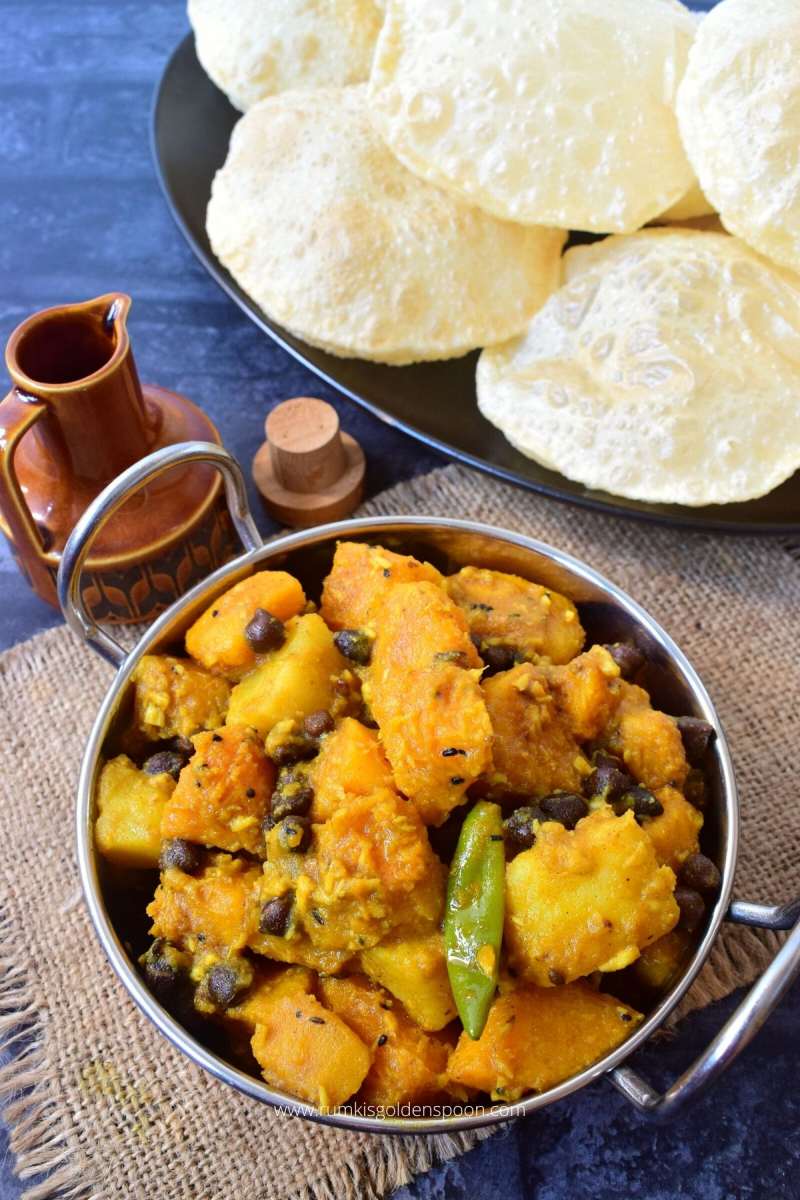Kumror chokka is an old Bengali veg recipe which is hugely popular in Eastern India. It is a slightly sweet and spicy dry curry where ripe pumpkin pieces are cooked with potato chunks, black chickpeas, grated coconut, little bit of ghee and some spices. It is a no onion no garlic recipe which goes perfect for vegetarian days. Luchi & kumror chokka is one of the most popular breakfast combos in Bengali cuisine which is frequently prepared in festive days and Bengali biye bari (Marriage function). Kumror chokka recipe has even occupied place in many authentic restaurant’s menu card. Other than luchi, it can also be accompanied a side with hot steamed rice and dal and sometimes with flat bread like rotis or parathas.
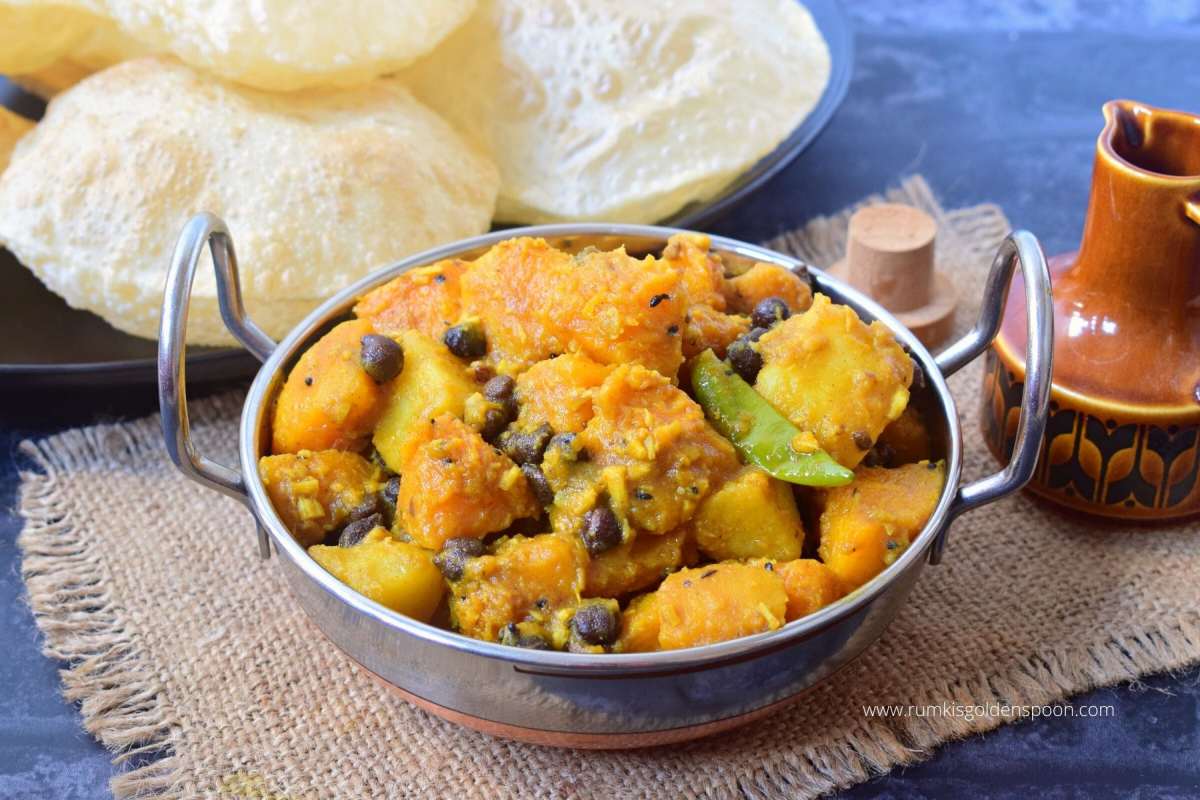
Table of Contents
About the recipe
Health Benefits of Pumpkin
Tips and Suggestions
How to make Kumror chokka (step wise photos)
Recipe Card
About the recipe
Kumror chokka recipe is mostly prepared in vegetarian way. Though this dish is prepared with veggies but still Bengalis are scrupulous about vegetarian food. They have split it into two different parts. One division is called satvik food where onion, garlic and even masoor dal are prohibited along with non-vegetarian items. In another division, normal vegetarian dishes are prepared using onion and garlic. Onion and garlic are considered as rajasik food which produces heat in our body and inflame our passion, incomprehension. So, this misti kumro recipe belong to the satvik family because it does not contain onion and garlic.
Pumpkin is a very famous vegetable all over the world and many delectable dishes including soup, pie, dessert, curries etc. are prepared with this ingredient. During the autumn season, this giant squash appears and is used to prepare varieties of dishes during Halloween.
In fact, pumpkin aka mishti kumro is one of the regularly used vegetable in both Bengali vegetable recipe and non-vegetarian recipes. Sometimes it is used as the key ingredient in many dishes whereas sometimes it is used with other vegetables to prepare different dishes.
Since my childhood, I have been brought up eating varieties of luscious dishes with this versatile vegetable. Misti kumror chokka, misti kumro diye macher matha, misti kumro diye chigri macher jhol, misti kumror bora, misti kumra bhorta, labra etc. are few popular names of the dishes of pumpkin in Bengali cuisine.
Whenever I talk about niramish kumror chokka, it always makes me feel nostalgic. As a bong, I have grown up eating this delicacy and have never got bored with it. I still remember how my mother used to prepare it on vegetarian days and puja days. She used to serve it mostly as a side with phulko luchi and we used to devour that with immense pleasure.
I have learnt this Kumror chokka recipe from my mom and she got the recipe from her mom, I mean my grandmother. This is signature dish but still every family have their own preferences to prepare the dish. The core ingredients remain same, but few ingredients or proportion of ingredients may vary in every house, according to their own taste buds. Like, many people prefer to add grated coconut or Bengal gram into the curry and few not.
After coming to the UK, I was missing the old traditional Bengali food very badly. Suddenly, one day in autumn, near the Halloween festival, I spotted pumpkins in the supermarket. Then without wasting any time, I grabbed one and decided to prepare few of the dishes with it. Mishti kumror chokka, labra and misti kumra bhaji have occupied the top position of my list.
Kumror chokka is a very simple and easy recipe and the difficulty level of cooking this dish is low. It could be a perfect option for beginners. The longest part of the recipe is to cut and clean the pumpkin. Other than this, it gets prepared very quickly without any hassle. All the ingredients required to prepare the dish are easily available in any Bengali kitchen pantry.
Kumror chokka with step by step photos and instructions have been provided in the ‘Instructions’ section. But before directly jumping into the recipe, let me share few interesting facts about the key ingredient pumpkin.
Health Benefits of Pumpkin
- It is a great source of Vitamin A, Vitamin C and minerals which helps to boost immune system.
- It is rich in antioxidants which helps to get rid of chronic diseases.
- It is good for our vision too.
- It is high in fibre and low in calorie which makes it a great option for weight loss.
- It is good for our skin health.
- In many cases it helps to control the blood pressure and blood sugar level of our body.
Tips to prepare perfect kumror chokka
- Fry the pumpkins separately and keep it aside because both potatoes and pumpkin have different cooking time.
- Always use mustard oil to cook aloo kumror chokka. It gives better flavour to the dish.
- Don’t skip the whole spices from the recipe. It induces nice aroma into the oil.
- Addition of grated coconut enhances the taste and flavour of the dish to another level.
- Don’t skip the Bengali garam masala powder and ghee from the recipe. It gives the authentic Bengali flavour of the dish.
- Kumror chokka is slightly sweet in taste. Hence, a little bit of sugar is added to the dish.
- You can adjust the amount of chillies according to your own preferences.
How to make Kumror chokka?
To prepare the kumror chokka recipe, first peel and cut the pumpkins into medium diced pieces. Rinse them and discard extra water from the pumpkin pieces. Keep it aside.
Cut the potatoes into medium sized pieces and keep them aside.
Then put a pan on flame and allow it to become completely dry. Add mustard oil into the pan and wait until the oil is hot. Generally, most of the traditional Bengali food is cooked in mustard oil. It gives an outstanding flavour to the dish.
Add the pumpkin pieces into the pan. Add salt and give a nice mix. Then fry them over medium to medium high flame until brown patches occur on the pumpkin pieces. Keep them aside on a separate plate.
In the same pan, add whole spices – bay leaf, dry red chillies, panch phoran and let them crackle. Then add a pinch of hing aka asafoetida and stir it for few seconds.
Add potato chunks, salt into the pan and give a nice mix. Cover the pan and cook it over medium flame for 5 minutes. Stir twice in between.
In the meantime, take a bowl and add ginger paste, turmeric powder, red chilli powder, cumin powder, coriander powder and some water into it. Make a smooth paste of the spices and add it into the pan. Cook it in low flame for another 3-4 minutes until the raw smell disappears and the masala starts releasing oil.
Add the fried pumpkin pieces into the pan and give a nice mix. Cover the pan and cook it in low flame for a minute.
Then add the grated coconut into the pan and give a nice mix. Cover the pan and cook it in low flame for 2-3 minutes until the raw smell of coconut goes away.
Add boiled black chickpeas, green chillies and give a nice mix. Cover the pan and cook it over low flame until the pumpkin and potatoes get cooked properly.
Add water for the gravy and give a nice stir. Cover the pan and put the flame in high until the gravy starts boiling. Then put the flame in low and cook it for another 2-3 minutes.
The consistency of kumror chokka is neither like a dry curry nor like curry with gravy. It is moist in texture coated with thick gravy. In Bengali, it is termed as makha-makha.
At the final stage of cooking, add sugar, bengali garam masala powder (a ground spice mixture which contains equal portion of cardamom, cinnamon and cloves) and ghee (clarified butter), one by one into the pan. These spices complement the flavour of the dish very well.
Check the salt of the curry and add if required. Simmer the gravy for 10-15 more seconds and then switch off the flame.
Many traditional Bengali food have already shared in my previous posts. You can check few of them like
Chanar Dalna
Aloo Posto
Mocha ghonto
Echorer dalna
Aloo potoler dalna
..And Many more…
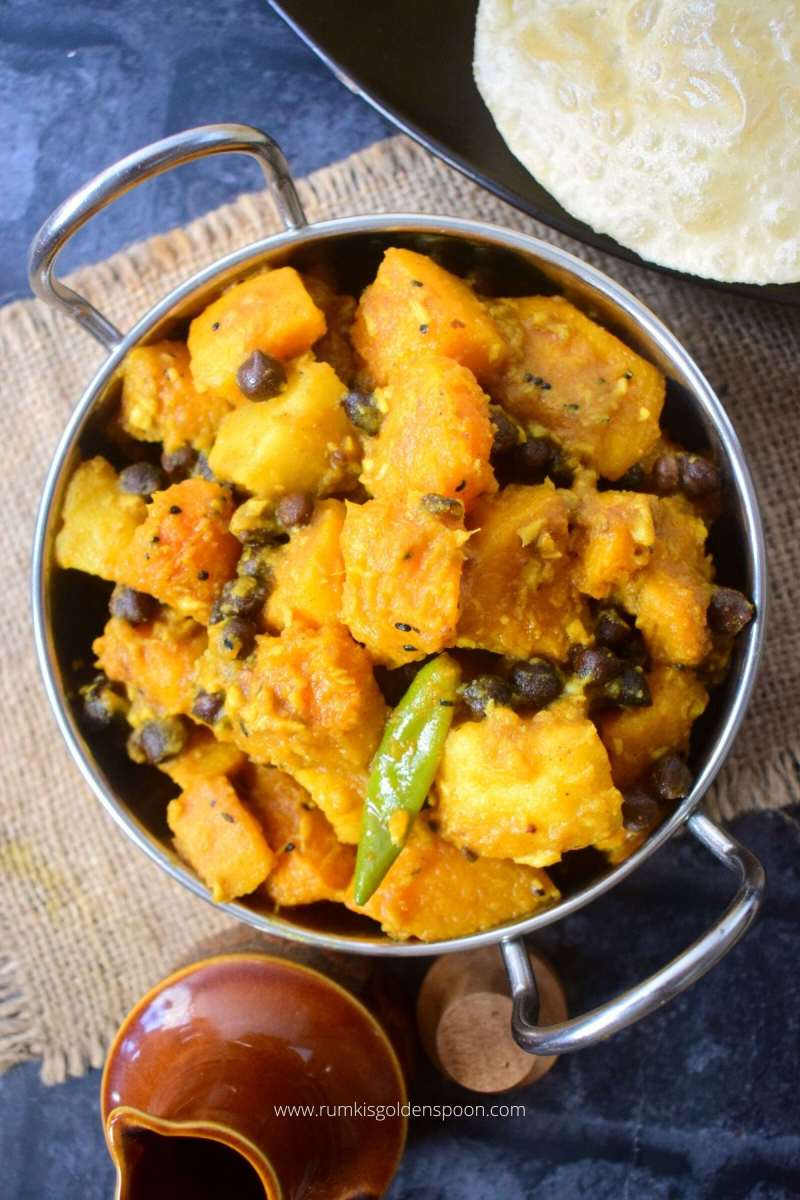
Ingredients:
1 cup = 250 ml
- 500 grams Pumpkin (Misti kumro)
- 2 medium Potatoes
- 2-3 green Chillies
- ½ cup black Chickpeas, boiled
- 3 tablespoons grated Coconut
- 2 dry red Chillies
- 1 Bay leaf
- ¾ teaspoon Panch phoran
- ¼ teaspoon Hing (Asafoetida)
- 1 teaspoon Bengali Garam masala
- 1 tablespoon Ghee (Clarified butter)
- 1 teaspoon Sugar
- Salt to taste
- 4 tablespoons Mustard oil for cooking
- 1½ cup Water for gravy
For masala paste
- 1 tablespoon Ginger paste
- ½ teaspoon Turmeric powder
- 1 teaspoon red Chilli powder
- 1 teaspoon Cumin powder
- ¾ teaspoon Coriander powder
- 3 tablespoons Water
Instructions:
- First cut and make medium dices of pumpkin and potatoes, wash them, and keep aside separately.
- Put a pan on flame and allow it to become completely dry. Then add 4 tablespoons mustard oil into the pan and wait until the oil is hot.
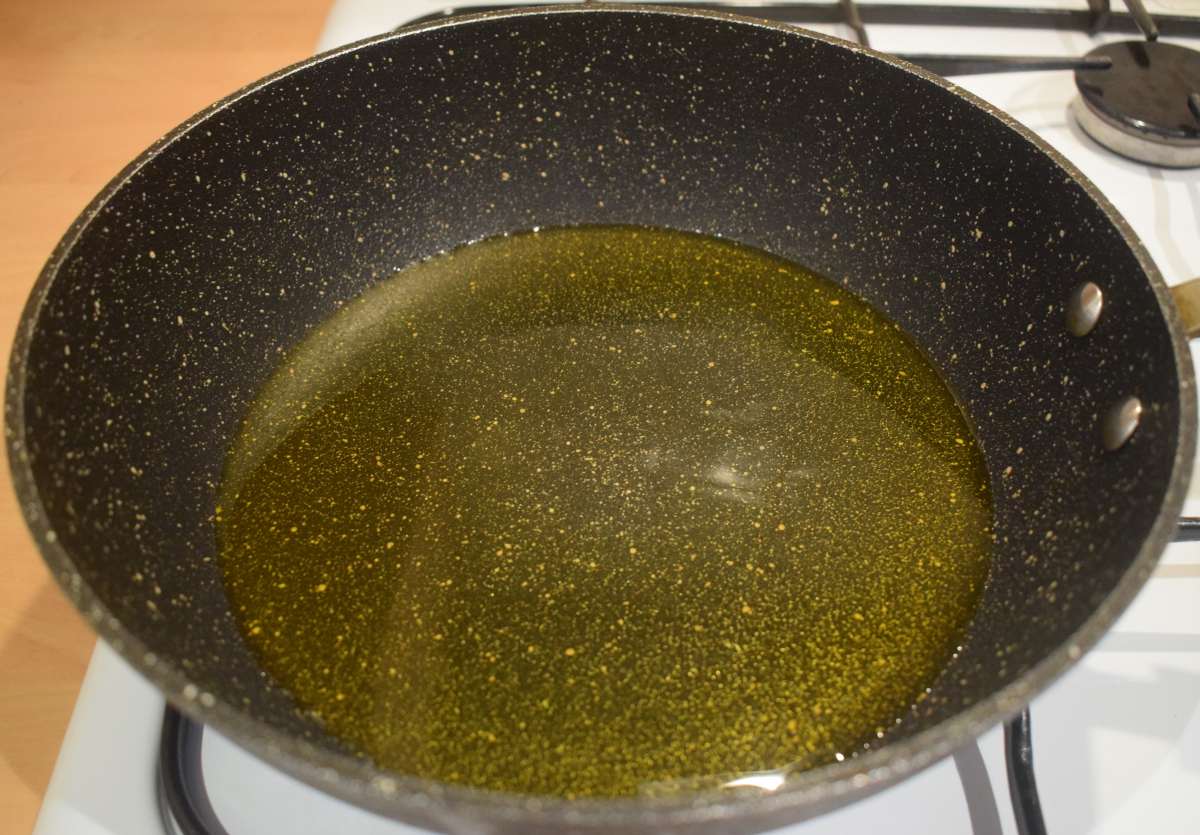
- Add the pumpkin pieces into the pan. Add salt and give a nice mix. Then fry them over medium to medium high flame until brown patches occur on the pumpkin pieces. Keep them aside on a separate plate.
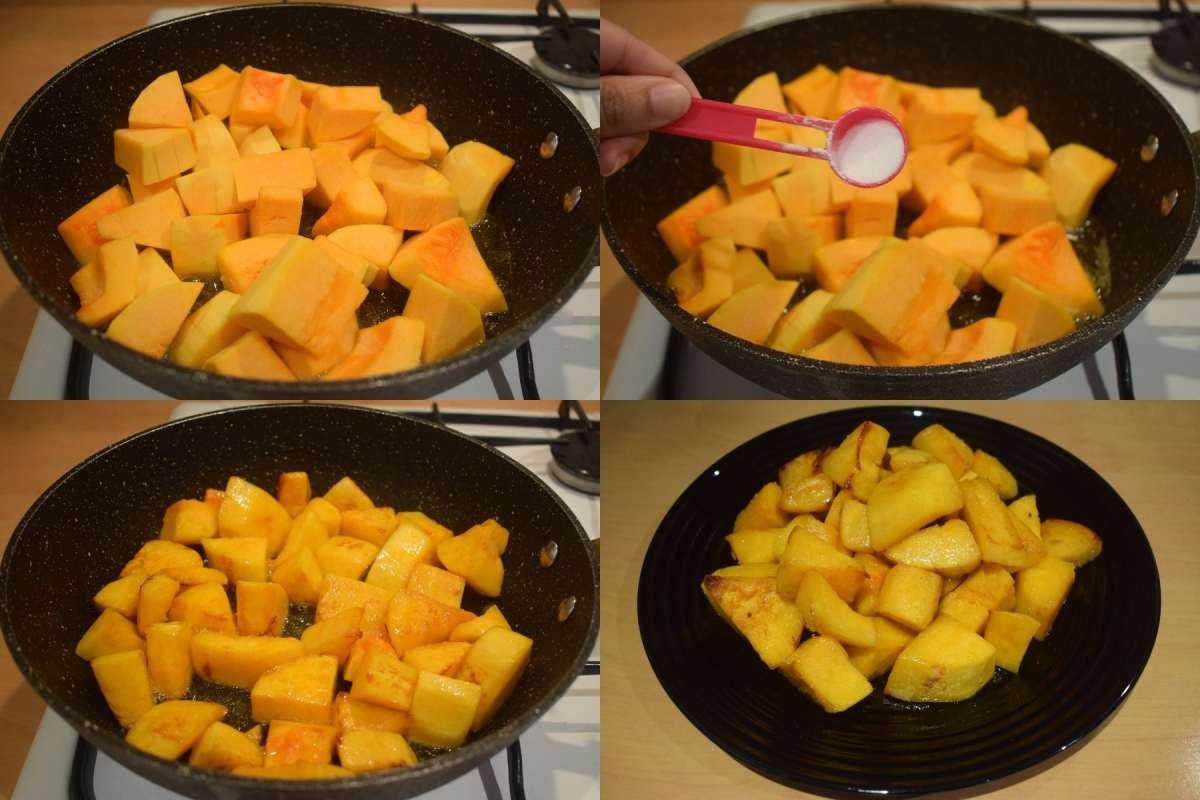
- In the same pan, add whole spices – 1 bay leaf, 2 dry red chillies, ¾ teaspoon panch phoran and let them crackle. Then add ¼ teaspoon hing aka asafoetida and stir it for few seconds.

- Add the potato chunks, salt into the pan and give a nice mix. Cover the pan and cook it over medium flame for 5 minutes. Stir twice in between.

- In the meantime, take a bowl and add 1 tablespoon ginger paste, ½ teaspoon turmeric powder, 1 teaspoon red chilli powder, 1 teaspoon cumin powder, ¾ teaspoon coriander powder and 2-3 tablespoons water into it. Make a smooth paste of the spices.


- Add the paste into the pan and mix it well. Cook it in low flame for another 3-4 minutes until the raw smell disappears and the masala starts releasing oil.
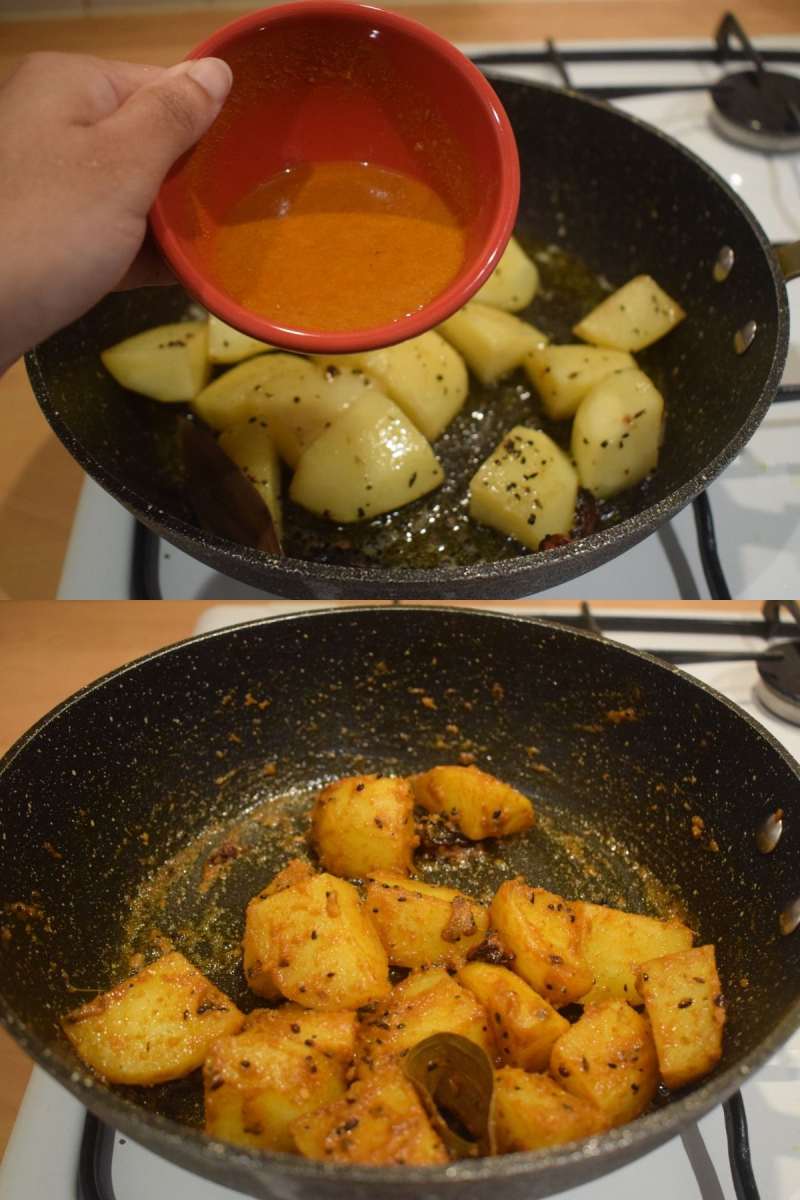
- Add the fried pumpkin pieces (Step 3) into the pan and give a nice mix. Cover the pan and cook it in low flame for a minute.

- Add 3 tablespoons grated coconut into the pan and give a nice mix. Cover the pan and cook it in low flame for 2-3 minutes until the raw smell of coconut goes away.
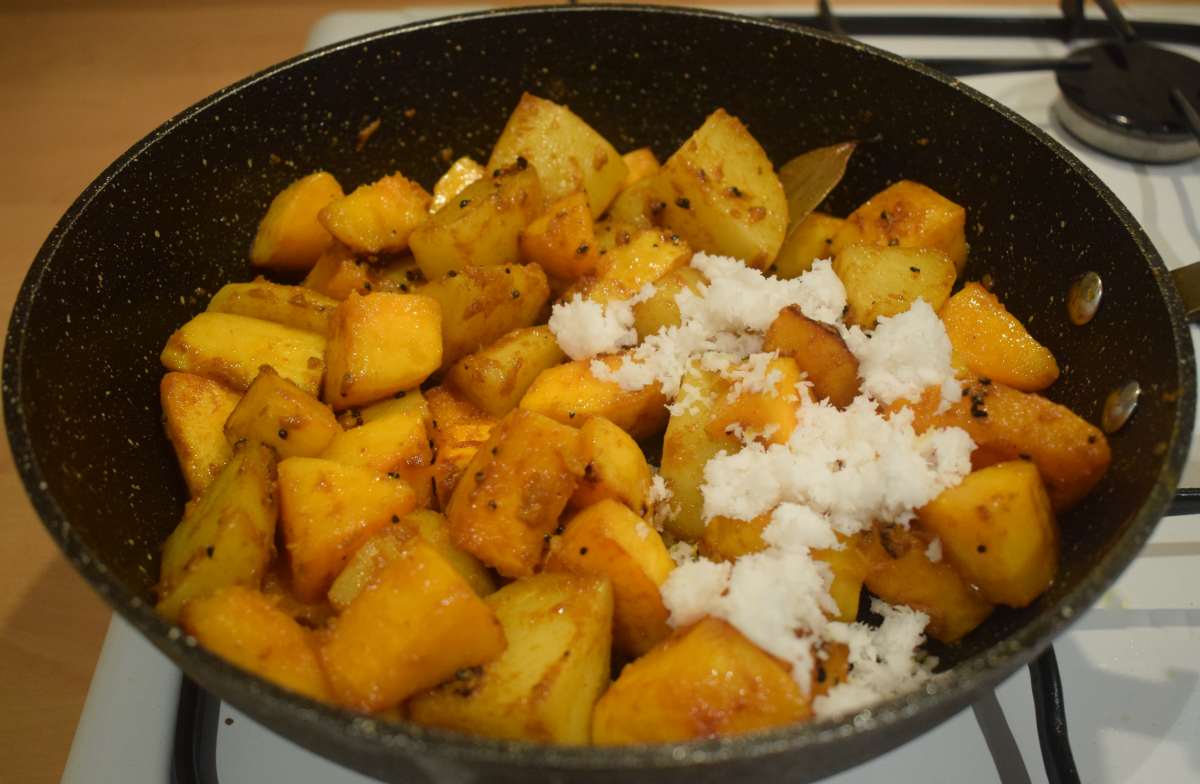
- Add ½ cup boiled black chickpeas, 2-3 green chillies and give a nice mix. Cover the pan and cook it over low flame for another 4-5 minutes until the pumpkin and potatoes get cooked perfectly.
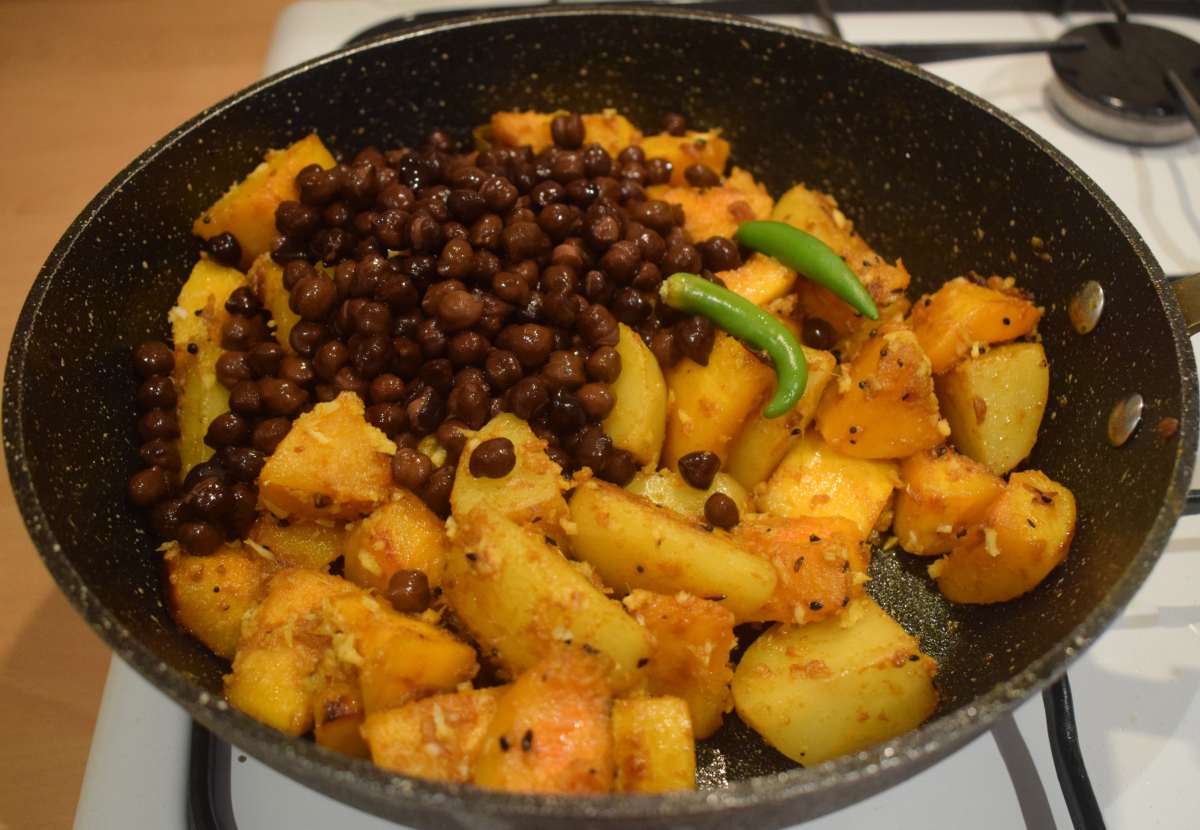
- Add 1½ cup water for the gravy and give a nice stir. Cover the pan and put the flame in high until the gravy starts boiling. Then put the flame in low and cook it for another 2-3 minutes.

Note: The consistency of kumror chokka is neither like a stir fry nor like curry with gravy. It is moist in texture coated with thick gravy. In Bengali it is termed as makha-makha. - At the final stage of cooking, add 1 teaspoon sugar, 1 teaspoon bengali garam masala powder (a ground spice mixture which contains equal portion of cardamom, cinnamon and cloves) and 1 tablespoon ghee (Clarified butter), one by one into the pan.
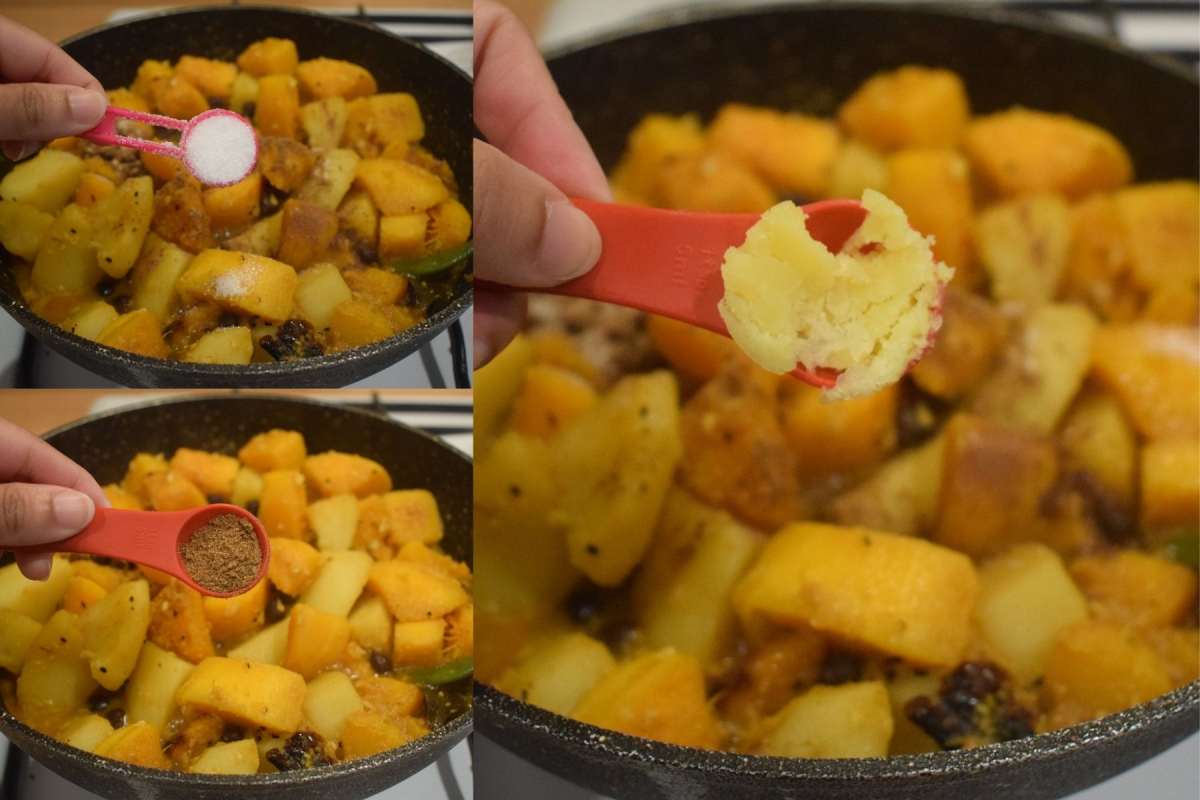
- Check the salt of the dish and add if required.
- Simmer the gravy for 10-15 more seconds in high flame and then switch off the flame.
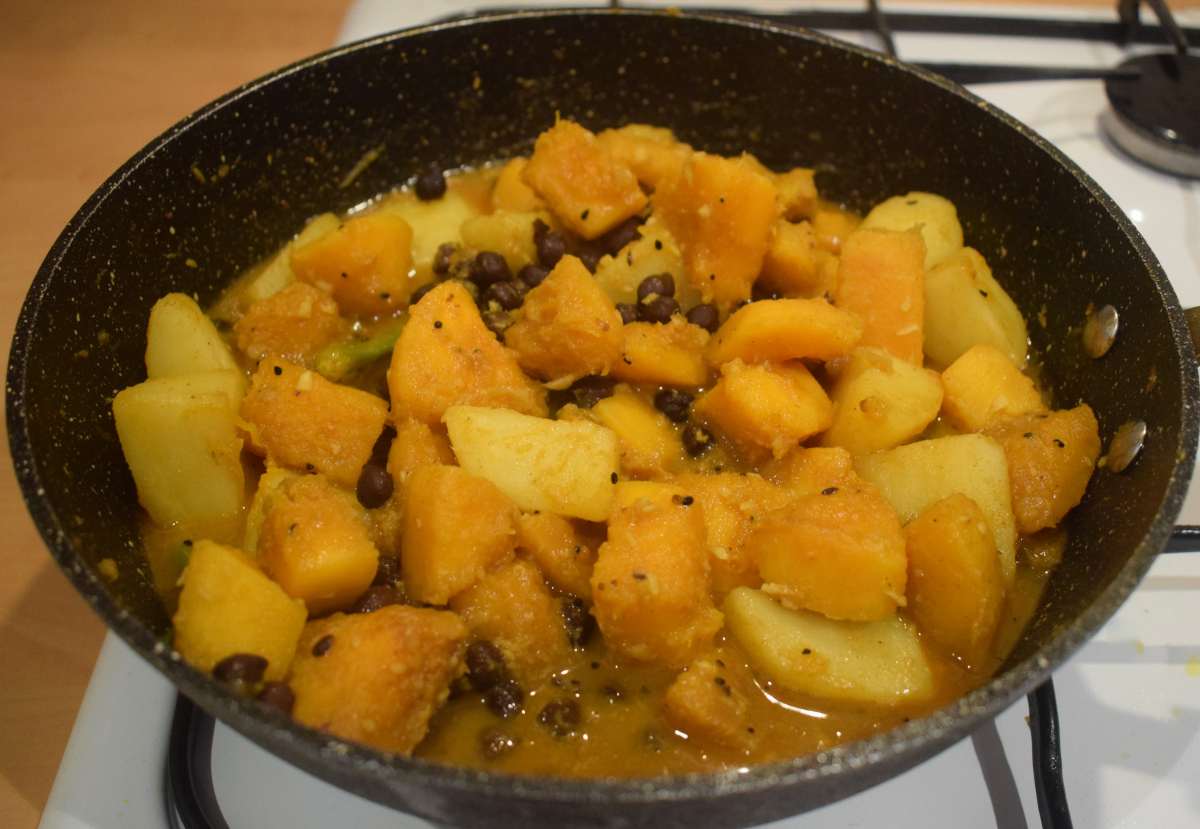
Serving Instruction
Transfer the kumror chokka into a serving bowl or on a serving plate and serve hot or warm. Pair up the comfort food with steamed Basmati rice and dal and enjoy your comfort meal. You can also accompany the dish with flat breads like luchi, rotis, phulkas and parathas.
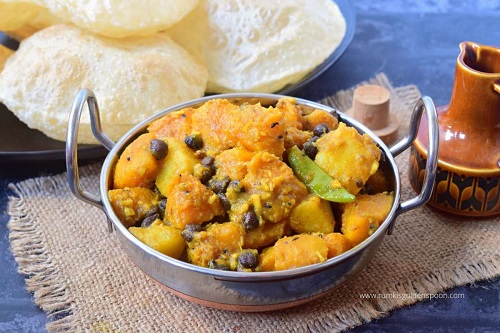
Ingredients
1 cup = 250 ml
- 500 grams Pumpkin (Misti kumro)
- 2 medium Potatoes
- 2-3 green Chillies
- ½ cup black Chickpeas, boiled
- 3 tablespoons grated Coconut
- 2 dry red Chillies
- 1 Bay leaf
- ¾ teaspoon Panch phoran
- ¼ teaspoon Hing (Asafoetida)
- 1 teaspoon Bengali Garam masala
- 1 tablespoon Ghee (Clarified butter)
- 1 teaspoon Sugar
- Salt to taste
- 4 tablespoons Mustard oil for cooking
- 1½ cup Water for gravy
For masala paste
- 1 tablespoon Ginger paste
- ½ teaspoon Turmeric powder
- 1 teaspoon red Chilli powder
- 1 teaspoon Cumin powder
- ¾ teaspoon Coriander powder
- 3 tablespoons Water
Instructions
- First cut and make medium dices of pumpkin and potatoes, wash them, and keep aside separately.
- Put a pan on flame and allow it to become completely dry. Then add 4 tablespoons mustard oil into the pan and wait until the oil is hot.
- Add the pumpkin pieces into the pan. Add salt and give a nice mix. Then fry them over medium to medium high flame until brown patches occur on the pumpkin pieces. Keep them aside on a separate plate.
- In the same pan, add whole spices - 1 bay leaf, 2 dry red chillies, ¾ teaspoon panch phoran and let them crackle. Then add ¼ teaspoon hing aka asafoetida and stir it for few seconds.
- Add the potato chunks, salt into the pan and give a nice mix. Cover the pan and cook it over medium flame for 5 minutes. Stir twice in between.
- In the meantime, take a bowl and add 1 tablespoon ginger paste, ½ teaspoon turmeric powder, 1 teaspoon red chilli powder, 1 teaspoon cumin powder, ¾ teaspoon coriander powder and 2-3 tablespoons water into it. Make a smooth paste of the spices.
- Add the paste into the pan and mix it well. Cook it in low flame for another 3-4 minutes until the raw smell disappears and the masala starts releasing oil.
- Add the fried pumpkin pieces (Step 3) into the pan and give a nice mix. Cover the pan and cook it in low flame for a minute.
- Add 3 tablespoons grated coconut into the pan and give a nice mix. Cover the pan and cook it in low flame for 2-3 minutes until the raw smell of coconut goes away.
- Add ½ cup boiled black chickpeas, 2-3 green chillies and give a nice mix. Cover the pan and cook it over low flame for another 4-5 minutes until the pumpkin and potatoes get cooked perfectly.
- Add 1½ cup water for the gravy and give a nice stir. Cover the pan and put the flame in high until the gravy starts boiling. Then put the flame in low and cook it for another 2-3 minutes.
Note: The consistency of kumror chokka is neither like a stir fry nor like curry with gravy. It is moist in texture coated with thick gravy. In Bengali it is termed as makha-makha.
- At the final stage of cooking, add 1 teaspoon sugar, 1 teaspoon bengali garam masala powder (a ground spice mixture which contains equal portion of cardamom, cinnamon and cloves) and 1 tablespoon ghee (Clarified butter), one by one into the pan.
- Check the salt of the dish and add if required.
- Simmer the gravy for 10-15 more seconds in high flame and then switch off the flame.
KITCHEN TOOLS for the recipe:
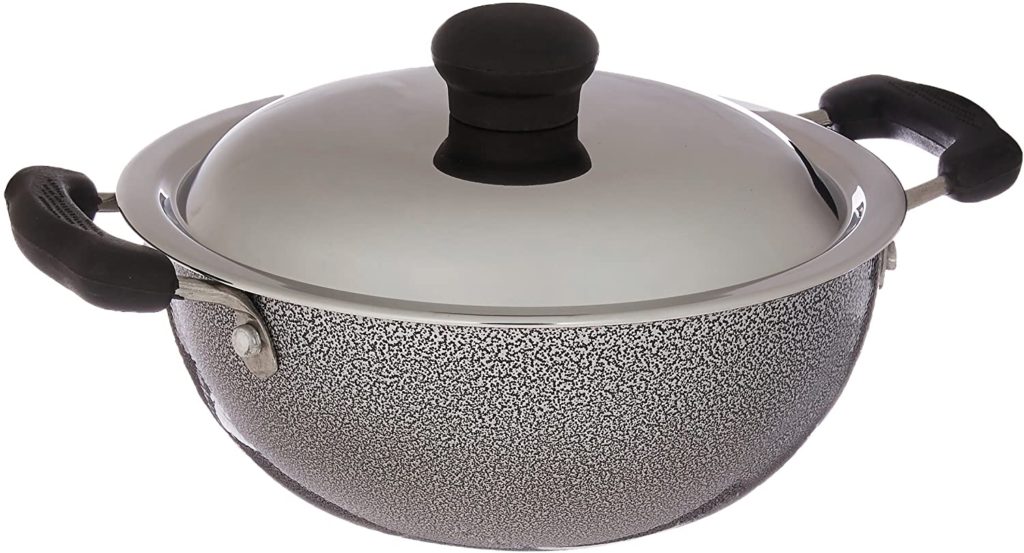
Kadai

Wooden Spatula


